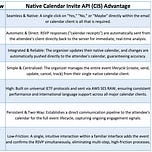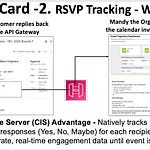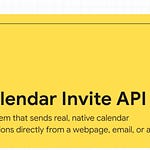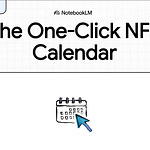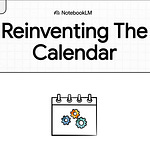Calendar Invite Server: A Technical Whitepaper on Architecture, Functionality, and Deployment
1.0 Introduction: Redefining Event Communication
In digital event marketing, a significant gap exists between an organizer’s intent and an attendee’s action. Traditional “Add to Calendar” buttons and separate RSVP forms create a high-friction, unreliable experience, often resulting in disconnected data and missed communication opportunities.
The Calendar Invite Server (CIS) is a standards-compliant, API-driven solution designed to address this challenge by establishing a direct, persistent communication channel with an attendee’s native calendar. This whitepaper provides a comprehensive architectural overview of the CIS, its core processors, first-party data collection mechanisms, and deployment model for technical stakeholders and potential partners.
The primary goal of the CIS is to transform static event data into dynamic, updatable calendar invitations that mimic and extend the functionality of enterprise calendar servers, such as Google or Microsoft. By leveraging an organization’s existing calendar client as the primary management interface, the CIS creates a seamless workflow for sending, tracking, updating, and canceling events directly on a customer’s calendar. This document will deconstruct the server’s modular architecture, analyze its competitive advantages, outline key use cases, and detail the packaging and deployment process.
2.0 Architectural Overview: The Core Processing Engine
The strategic foundation of the Calendar Invite Server is its modular, three-processor architecture. This design, built entirely on AWS serverless services, ensures massive scalability, high reliability, and a clear separation of concerns. Rather than operating in isolation, these processors form a continuous, automated feedback loop. Each processor is responsible for a distinct phase in the lifecycle of a calendar event—from initial creation to final cancellation—creating a robust and automated messaging pipeline. The following sections deconstruct the function and workflow of each core processor.
2.1 The Inbound Processor: Ingesting and Storing Event Data
The Inbound Processor serves as the entry point for all event data, establishing a critical link between an organizer’s native calendar client and the CIS. The workflow is initiated when an organizer creates an event in their standard calendar (e.g., Google Calendar, Outlook) and sends the invite to a designated CIS email address.
The step-by-step logic is as follows:
An organizer’s calendar invite is sent to a designated AWS Simple Email Service (SES) email address (e.g., create@calendarsnack.com).
The raw event data is received and programmatically disassembled into its core components.
The event is stored in the database (DynamoDB) with a status of “NEW”.
A unique UID is generated and assigned to the event, creating a persistent association with the organizer’s email address.
This process transforms a simple calendar entry into a manageable data object within the CIS pipeline. This persistent link is crucial, as it enables the organizer to use their native calendar client to push subsequent updates and cancellations through this exact inbound mechanism, which in turn triggers the Update & Cancel Processor.
The Inbound Processor is built upon a stack of highly available AWS services:
SES (Simple Email Service): Receives the initial invite from the organizer.
SNS (Simple Notification Service) & SQS (Simple Queue Service): Manage the notification and queuing of incoming event data for processing.
Lambda: Executes the core business logic for disassembling the invite and storing its components.
S3 (Simple Storage Service): Provides durable storage for the raw invite data.
DynamoDB: Stores the structured, disassembled event data for fast retrieval.
2.2 The Outbound Processor: API-Driven Invite Distribution
The Outbound Processor is responsible for distributing calendar invites to attendees on demand. This API-first approach provides the flexibility to integrate calendar invitations into any digital touchpoint.
The outbound data flow proceeds as follows:
An API call is made, specifying the organizer’s email (from address) and the target attendee’s information, which includes the UID for the event and the attendee's email Address.
The API matches the organizer’s email to the corresponding Event UID stored by the Inbound Processor.
Lambda functions retrieve the event components from DynamoDB and reassemble them into a standards-compliant calendar invite.
The complete invite package is sent to the attendee using AWS SES RAW. This service is critical as it ensures the invite is correctly formatted for universal compatibility and supports international languages.
A calendar receipt (RSVP) is explicitly requested from the recipient’s calendar client, initiating the data collection feedback loop.
This API-driven methodology empowers organizations to embed dynamic calendar functionality directly into RSVP buttons, web pages, email marketing campaigns, and custom applications, as detailed later in this document.
2.3 The Update & Cancel Processor: Managing the Event Lifecycle
The Update & Cancel Processor automates the propagation of event changes, ensuring that all attendees have the most current information directly on their calendars. This workflow is triggered whenever an organizer modifies or deletes the original event in their native calendar client and saves the changes, which automatically resends the data to the Inbound Processor.
The system handles two primary scenarios:
Updates: When an organizer edits event details (e.g., date, time, location, or even adding promotional text to the description) and saves the event, the updated data is ingested. The CIS automatically identifies all recipients who previously responded with ‘Yes’ or ‘Maybe’ and distributes the updated calendar invite to them. This ensures that only engaged attendees receive notifications about changes.
Cancellations: When an organizer cancels the event in their calendar client, a cancellation notice is sent to all customers who initially received an invite for that Event UID, regardless of their RSVP status. The event data is retained for analytical purposes but is marked as “canceled” to prevent any further actions.
For enhanced control, an optional workflow switch can be enabled within a Lambda function. This feature allows for manual approval by the organizer before any automated updates or cancellations are sent to attendees, providing a layer of governance for critical communications. This automated, full-lifecycle management transforms the calendar from a static entry into a dynamic communication channel, the strategic value of which is rooted in the first-party data it generates.
3.0 Data Collection and First-Party Analytics
The actual strategic value of the Calendar Invite Server lies in the first-party data it captures. Unlike the disconnected information gathered from traditional web forms, the CIS transforms the calendar into a live channel for measuring attendee intent. Every interaction—from the initial RSVP to any subsequent changes—becomes a valuable data point.
This real-time, persistent RSVP tracking provides a continuously updated view of engagement, a stark contrast to the static, one-time snapshot from a web form, enabling more accurate forecasting and audience segmentation.
The data collection mechanism is initiated by a request for a “calendar receipt” embedded within every outgoing invite. When a recipient responds by clicking ‘Yes’, ‘No’, or ‘Maybe’ in their native calendar client, that response is automatically sent back to the CIS API Gateway.
The data pipeline for these receipts is as follows:
The API Gateway receives the RSVP response.
The raw response data is stored in S3 for archival and auditing.
The data is processed and stored in DynamoDB, where it is associated with the specific event and attendee for analytics and decision-making.
Crucially, this is not a one-time event. If an attendee later changes their status (e.g., from ‘Maybe’ to ‘Yes’), the update is automatically transmitted back to the CIS, and the record is updated accordingly. This creates a persistent, real-time view of attendee commitment. The technical mechanism for this is a standards-compliant block within the invite data:
ATTENDEE; PARTSTAT=NEEDS-ACTION; ROLE=REQ_PARTICIPANT; RSVP=TRUE; SCHEDULE STATUS=1.1:mailto:zack@techvader.com
ORGANIZER;CN=greghanchin[at]31events.com;SENT-BY=”mailto:rsvp@calendarsnack.com”:mailto:rsvp@calendarsnack.com
This direct, automated data flow provides organizations with unparalleled insight into attendee engagement, turning a simple event invitation into a powerful tool for understanding audience behavior.
4.0 Competitive Advantage: Native Invites vs. “Add to Calendar”
The CIS methodology of sending native calendar invites offers distinct and compelling advantages over the standard but flawed approach of using “Add to Calendar” buttons linked to static .ics files and separate RSVP web forms. The following analysis highlights the superiority of the CIS architecture in key operational areas.
4.1 Why Calendar Invites are better than Add to Calendar
In summary, the CIS approach provides a superior, low-friction user experience while establishing a more reliable, integrated, and data-rich workflow for organizers.
5.0 Core Use Cases and API Applications
The Calendar Invite Server’s architecture is designed for flexible implementation across a wide range of digital channels. The Calendar Invite REST API is the key that unlocks this versatility, enabling partners to embed dynamic event functionality wherever their audience engages. The following subsections detail the four primary use cases.
5.1 Use Case 1: Web Page Integration
The API can be used to send calendar invites directly from any web page. This is ideal for event landing pages, webinar registration confirmation pages, or appointment booking sites. A typical implementation involves creating auto-generated landing pages where users enter their email addresses to receive a “1-Click Calendar Invite,” dramatically reducing friction and increasing calendar booking rates.
5.2 Use Case 2: Email Marketing Enhancement
Organizations can generate RSVP Button API codes directly from the CIS console for embedding into email marketing templates. This functionality is compatible with over 50 major email marketing vendors. When a recipient clicks the call-to-action button in an email campaign, the API sends the calendar invite and can simultaneously redirect the user to a custom landing page. This page can leverage an “Upcoming Events theme,” presenting other available events for self-selection and driving further engagement.
5.3 Use Case 3: Custom Application Workflows
The REST API enables deep integration with custom applications and backend workflows. For example, an application could feature an event picker that allows users to select an event, upload a list of email addresses, and send bulk invitations. This is also ideally suited for transactional use cases, such as automatically sending calendar invites for invoice due dates, shipping notifications, scheduled maintenance reminders, or sending mass reminders for events to which users have already signed up via other forms.
5.4 Use Case 4: Large-Scale Event Schedules
(Case Study: NFL Demo)
The CIS is architected to power complex, large-scale custom event sites, as demonstrated by a proof-of-concept built for the entire 272-game NFL season schedule. This mini-site illustrates the platform’s ability to handle thousands of events and deliver a highly engaging user experience.
Key capabilities demonstrated in the case study include:
Event Virtualization: Every game is modeled as a ready-to-send, standards-compliant ICS invite, transforming a static schedule into an interactive platform.
Dynamic Updates: Changes such as flex scheduling or cancellations are automatically pushed directly to fans’ calendars, ensuring the calendar remains the single source of truth.
Frictionless UX: Fans can add a game to their calendar with a single click from a mobile-responsive interface built with Vue 3 and Tailwind CSS.
First-Party Data Collection: The system tracks the real-time RSVP status (Yes, No, Maybe) for every invite, creating a live intent signal that measures fan engagement.
Data Enrichment: Raw game data is enhanced with contextual information retrieved from public APIs, including team details, week groupings, and post-game scores, making the calendar entry valuable before, during, and after the event.
The demo site’s technical architecture features a Vue 3 frontend, Pinia for state management, and a UTC-first timezone strategy to ensure accurate display for a global audience. This case study validates the CIS’s capacity to manage high-volume, dynamic event data at scale.
6.0 Deployment, Packaging, and Security
The Calendar Invite Server is designed for partner deployment and ownership under a “you own it and you run it” model. This approach is critical for the target audience as it guarantees data sovereignty, provides an enhanced security posture by operating within the partner’s own AWS account, and allows for unlimited integration potential within their existing ecosystem. The product is delivered in two core packages.
Backend: The core server logic is delivered as an AWS CloudFormation template. This template automates the deployment of the complete Inbound, Outbound, and Update/Cancel processors. The core AWS services deployed by the template include: SNS, SQS, SES, SES RAW, Route 53, API Gateway, Lambda, DynamoDB, S3, CloudFormation, and CloudWatch.
Frontend: A web-based console for organizers, built in Vue.js, provides a user-friendly interface for managing events. This console communicates directly with the nine developer-accessible APIs exposed by the deployed backend.
The target customer profiles for this solution include:
Large digital marketing agencies manage extensive web and email campaigns for multiple brands.
Software OEMs (e.g., HubSpot, SAP) are seeking to integrate native calendar functionality into their platforms for marketing or transactional purposes.
AWS Partners are looking to add a proven, high-value solution to the AWS Marketplace to serve their customer base.
The security of the platform is inherited from its underlying infrastructure. The deployment model relies entirely on AWS Serverless Security Best Practices within the customer’s own AWS account, providing a secure, robust, and isolated environment for each partner.
7.0 Conclusion: The Future of Event-Driven Communication
The Calendar Invite Server fundamentally redefines the relationship between an organization and its audience by transforming the humble calendar invite into a robust, persistent messaging pipeline. By enabling organizers to use their native calendar client as an interface, the CIS eliminates technical barriers. It streamlines the entire lifecycle management of an event—from creation and distribution to updates and cancellations—directly on their customers’ calendars.
The strategic benefits are clear: the ability to capture granular, first-party engagement data turns the calendar into a real-time intent signal; the standards-based architecture ensures reliable communication across all platforms; and the API-first design provides a seamless, low-friction user experience. For partners seeking to build deeper engagement and own their communication channels, the Calendar Invite Server offers a proven, scalable, and secure foundation for the future of event-driven communication.

